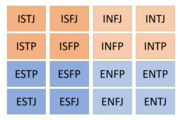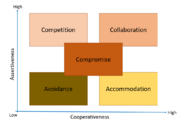Conflict management using the Myers-Briggs Type Indicator (MBTI)
"It is up to each person to recognize his or her true preferences." Isabel Briggs Myers
Conducting projects might tend to conflict between project managers and team members due to natural reasons. Humans are social beings, but basic differences in the ways people prefer to use their perception and judgement means that conflict is inevitable. While one individual might be positive about a decision made within a team, another one might perceive the action as terrifying. ADD CONSEQUENCES OF CONFLICTS IN PROJECTS(stress, timeconsuming, resigning, not efficient work) From a study stating the importance of conflict management by Thomas K.W. and Schmidt W.H. at the University of California, Los Angeles [1], it is shown that managers spend around 20 percent of their time dealing with conflicts. Another part of the survey worth pointing out is the sources of conflict which in this survey tended to be psychological factors such as misunderstanding (communication failure), personality clashes and value differences. Becoming aware of personal and other peoples preferences can help project managers handle conflicts more smoothly and be a key to build strong communication patterns that meets the needs for both the managers and the team members. This article will address the Myers-Briggs Type Indicator (MBTI), a four-factor model within personality typology with a purpose to help indicate personal communication preferences by four letters. It is a useful tool when managing a project as the indicator helps to build communication patterns and ideally analyze and prevent sources of conflict within a team. [2] [3]
(specify that this is "a start" of resolving problems. the indicator alone will not fix problems To start, this article will introduce some history on how the indicator was developed followed by the structure. Section 3 will describe how the MBTI can be applied and section 4 will discuss... not done
Contents |
History
The development of the MBTI began already in 1915 when Katharine Cook Briggs noticed how different her future son-in-law Clarence Myers was from her daughter Isabel. It inspired her to develop her own typology. In 1921 the swiss psychologist Carl G. Jung published Jung's personality Theory of psychological types which was similar to Myers and Briggs ideas, but much more developed. Myers and Briggs started aiming their work on making Jung's theory accessible to individuals and groups which led to the idea of creating an indicator. From 1941-43 Myers and Briggs begin to utilize the types as a measure to help people choose suitable work and to acknowledge differences. World war 2 was another huge factor on the development the MBTI, as Myers believed people would work better together and avoid conflicts if people understood each other. Myers dedicates the next 20 years creating questions and validation before the first published manual in 1962. The indicator has since then been updated by The Myers-Briggs Company. [4] [5]
Structure
Based on Jung's theory of psychological types, the MBTI are supposed to assign individuals into one out of four categories that describes methods in which individuals chose to make decisions and interact with others: Introversion(I) or Extraversion(E), Sensing(S) or intuition(N), Thinking(T) or Feeling(F) and Judging(J) or Perceiving(P). A person is said to tend to one of the preferences in each category, resulting in 16 unique possible personality types expressed as a code with the four letters. [3] [6]
The four categories
- Extraversion(E) vs Introversion(I)
This category is described by Jung as the attitude people use to direct their energy. Extraverts tends to direct their energy outwards and often feel energized by the presence of others. Introvert might on the opposite direct their energy inwards and feel energized after spending time alone.
- Thinking(T) vs Feeling(F)
This category describes how a person likes to make decisions and how they use judgement. If a person chose to focus on logic and objective principles before making a decision, the person is more of a thinker. If the person, on the other side chose to put more weight on personal concerns, the person is more of a feeler.
- Sensing(S) vs Intuition(N)
How does a person chose to gather and process information? People who are sensing-dominant focuses more on physical reality using their five senses, while a feeling-dominant person focuses more on pattern and meaning behind the information they get.
- Judging(J) vs Perceiving(P)
This category decides how a person deals with the outside world. A person that prefers a structured and decided lifestyle tends more to the judging side, while a person that is more open-minded and flexible tends more to the perceiving side.
Application in project management
This chapter will present how to use the tool in project management in order to manage conflict. It can first of all create more effective communication and collaboration within a project team. If a project manager becomes aware of their own and their team members' type, they might be able to tailor their communication style to match the preferences of team members who have a different type. This can also result in improved conflict resolution as the managers can identify potential sources of conflict and address them before they outburst into a conflict.
It is not an easy job to interpret the different types, however there are additional models that can be used in order to make the process more organized. For example there is the Thomas-Kilmann Conflict Mode Instrument (TKI®).
The Thomas-Kilman Conflict Mode Instrument
The Thomas-Kilman Conflict Mode Instrument (TKI®) is a world-known tool for conflict management that can help managers and other individuals understand different individuals behaviour in conflict situations and how it affects interpersonal and group dynamics. In a best possible scenario the assessment will help people prevent and reframe connflict, creating afficient outcomes. [7]
The instrument measures five conflict-handling "modes": competing, collaborating, compromising, avoiding and accomodating, which can be described in a two axis scale, asseriveness and cooperativeness as illustrated in Figure 2. How assertive a person is decribes to what extent that person tries to satisfy his or her own concers. On the other hand, cooperativeness describes to what extent that person tries to satisfy the other person's concerns. [7] [8] Each preference from the MBTI® can be described in each conflict mode in the TKI. For example, depending on how a person prefer to get their energy (extraversion or introversion) they have a different way of competing, collaborating, compromising, avoiding and accommodating. Similarly with how a person take in information (sensing or intuition), how the person make decisions (thinking or feeling) or how the person orient and organize him or her self in the world (judging or perceiving). [9]
Real life examples
Through interviews with four nurse managers conducted in the article "The Myers-Briggs Type Indicator - A management Tool" By Castello, K., the MBTI is demonstrated. [2]
project management [10]
Other sources to be looked at : conflict in projects: https://www.pmi.org/learning/library/understanding-managing-conflict-resolution-strategies-6484 understanding your type: https://www.mbtionline.com/en-US/Articles/2021/May/MBTI-Type-and-Conflict mbti conflict style report: https://www.themyersbriggs.com/en-US/Products-and-Services/-/media/myers-briggs/files/sample-reports/smp261161.pdf
Limitations
As a personality indicator reflecting upon the human mind, there are of course some limitations. First of all, the indicator is criticized of lacking scientific basis or empiric evidence and is, as mentioned earlier, based on Isabel Myers own observations and beliefs. It is therefor no evidence of the tool working at all. The tool also has limited reliablility and validity as studies shows that individuals often receive different results after taking the test multiple times.[11] Another limmitation of the tool is that it simplifies the complexity of human personalities. By categorizing people into dichotomous types, it fails to capture the many traits and variations that exists in each person.
Some examples of opponents thoughts are the statements of Adam Grant and Annie Murphy Paul. Adam Grant is an organizational psychologist as University of Pennsylvania and has written about the shortcoming of the MBTI, describing the accuracy of the indicator as "something in between the beliefs of horoscopes and a heart monito on the opposite side". He argues with other sources that the test is not reliable and that the 16 types has no scientific basis. [12] Annie Murphy Paul is an author and magazine journalist specializing especially in biological and social sciences. One of her books "The cult of personality testing" presents sceptical views of different personality test, among these the MBTI. She argues that the tests are intrusive and produce oversimplified descriptions of people that do not accurately capture the complexities and contradictions of human behavior across different contexts and over time. [11]
When utilizing the MBTI it is important to underline that there is no right or wrong answers and one should not define themselves a hundred procent on what an indicator is defining you as a person. Since it is a tool that define peoples personal treats and that it is not a scientific proven tool, it is of obvious reasons a sensitive subject mainly filled with personal opinions. In the end it is up to the individual if they chose to use the outcome of the tool or not, but they should bear in mind that there are several other factors that might play a bigger role.
Annotaded Bibliography
- "A Survey of Managerial Interests with Respect to Conflict" by Kenneth W. Thomas and Warren H. Schmidt: A survey conducted by
- "The Myers-Briggs type indicator--a management tool" by Kevin C.: an interview of four nurse managers demonstrating the MBTI.
- The Myers & Briggs Foundation
References
- ↑ "A survey of Managerial Interest with Respect to Conflict", Thomas, K. W. and Schmidt, W. H.,Academy of Management Journal, (1976),19(2),315-318
- ↑ 2.0 2.1 Costello K., "The Myers-Briggs type indicator--a management tool", Nurs Manage, 1993 May;24(5):46-7, 50-1. PMID: 8265080.
- ↑ 3.0 3.1 The Myers & Briggs Foundation, MBTI Basics, https://www.myersbriggs.org/my-mbti-personality-type/mbti-basics/ (accessed 16.02.2023)
- ↑ "How the Myers-Briggs Type Indicator Works", Cherry, K., URL: https://www.verywellmind.com/the-myers-briggs-type-indicator-2795583, (Accessed 15.02.2023)
- ↑ "The history of the MBTI® assessment", The Myers-Briggs Company, URL: https://eu.themyersbriggs.com/en/tools/MBTI/Myers-Briggs-history, (Accessed 16.02.2023)
- ↑ Simkus, J. (2022, March 10). An Overview of the Myers-Briggs Type Indicator. Simply Psychology. www.simplypsychology.org/the-myers-briggs-type-indicator.html(accessed 16.02.23)
- ↑ 7.0 7.1 Thomas, K. W. and Kilman R. H., "Thomas-Kilmann Conflict Mode Instrument, Profile and Interpretive Report", The Myers-Briggs Company, 01/10/2020, https://www.themyersbriggs.com/en-US/Products-and-Services/-/media/myers-briggs/files/sample-reports/smp248248.pdf (accessed 03.03.2023)
- ↑ Schaubhut N. A., "Technical Brief for the Thomas-Kilman Conflict Mode Instrument, Descrition of the Updated Normative Sample and Implications for Use", CPP Research Department, https://citeseerx.ist.psu.edu/document?repid=rep1&type=pdf&doi=c66b5c029273e62f57f469ea565cb05f7b051dbe(accessed 03/03/2023)
- ↑ "Using the TKI Assessment with the MBTI® Instrument", Psychometrics, https://www.psychometrics.com/wp-content/uploads/2015/08/tki-assessment-mbti.pdf (accessed 05/03/2023)
- ↑ Cohen, Yuval & Ornoy, Hana & Keren, Baruch, 2013, "MBTI Personality Types of Project Managers and Their Success: A Field Survey", Project Management Journal. 44. 10.1002/pmj.21338.
- ↑ 11.0 11.1 Paul A.M., "The Cult of Personality Testing: How Personality Tests Are Leading Us to Miseducate Our Children, Mismanage Our Companies, and Misunderstand Ourselves", 2010, Free Press, isbn: 9781451604061, url: https://books.google.dk/books?id=Njh9KgwSjs0C (accessed 29.03.23)
- ↑ Grant A., "Goodbye to MBTI, the Fad That Won’t Die", 2013, Psychology Today, URL: https://www.psychologytoday.com/intl/blog/give-and-take/201309/goodbye-to-mbti-the-fad-that-wont-die (accessed 27.03.2023)

